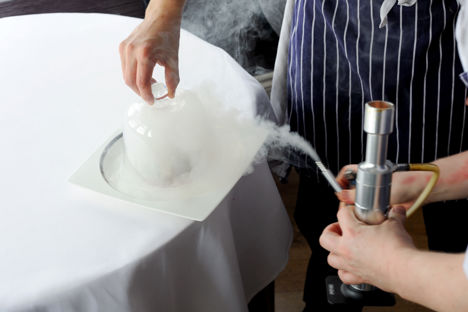Food smoking was, in the past, carried out for more pragmatic reasons than today - namely to preserve quickly spoiling fish and meat for the leaner months. Today, as with other traditional techniques like brining, curing and pickling, chefs are hooked on the unique flavours that smoking can bring to modern cuisine. While most meat and fish are smoked using aromatic wood chips, it is used today to impart all manner of delicate smoky flavours into food, from hay to herbal teas.
There are two types of smoking techniques, hot and cold. Hot smoking, at a temperature between 80-120°C, uses the smoke from a heat source to slow cook the meat and infuse it with flavour. Cold smoking food is more a type of curing and preserving technique, as the moisture is drawn out of the food before smoking gently at 25°C. The meat is then eaten in its ‘raw’ state. Both hot and cold smoking takes time, as no direct heat is being used; however this ensures that the tenderness of the meat is retained.
Method
There are two types of smoking techniques, hot and cold. Hot smoking, at a temperature between 80-120°C, uses the smoke from a heat source to slow cook the meat and infuse it with flavour. Cold smoking food is more a type of curing and preserving technique, as the moisture is drawn out of the food before smoking gently at 25°C. The meat is then eaten in its ‘raw’ state. Both hot and cold smoking takes time, as no direct heat is being used; however this ensures that the tenderness of the meat is retained.
Equipment
You may think that home smoking requires you to develop some kind of smokehouse den in the garage, but this is no longer the case, as products are now available to make your adventures in smoking as hassle-free as possible. There are, broadly speaking, two type of home smokers available for purchase - electric smokers, which are used for hot and cold smoking, and stove-top smokers, that use the direct heat of the hob to hot-smoke food. Electric smokers are great for beginners, as they allow you to precisely control the levels of heat and smoke, while stove-top smokers are portable and, with a bit of practice, allow you to experiment with all manner of hot smoked flavour combinations.
Uses
We are all used to smoked salmon, mackerel, haddock and ham, but in fact a wide range of ingredients can be smoked, from eel, as used by Shay Cooper, to offal, like Pascal Aussignac’s Hay-smoked pork kidney. Mushrooms and vegetables are also great for smoking, as Nuno Mendes demonstrates in his smoked enokisdish or with Marcus Wareing’s beautiful smoked baby beetroot dish. Just about anything can be smoked, but the time in the smoker and concentration of smoke varies depending on the types of ingredients used and how robust their flavours are.
Many fall foul to over-smoking food, which results in an acrid, overpowering flavour that can destroy all other elements on a plate. It’s always better to aim for subtlety, and remember that as long as smoke comes into contact with food, it will have at least some smoke flavouring.
How about smoking walnuts, to make smoked walnut pesto or tomatoes to make a smoked barbecue sauce
Get in touch
Please sign in or register to send a comment to Great British Chefs.


